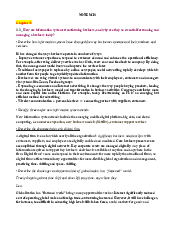



Preview text:
Chapter 6 – Case Study
Title: “How Reliable is Big Data” Group Members
Nguyen Kim Ngan – BAFNIU21216
Nguyen Bich Ngoc – BAFNIU21329
Tran Vo Duy Khang – BAFNIU21457 Question Answer What business benefits did
Technology companies such as Amazon, the organizations described
YouTube, and Spotify have flourished by in this case achieve by
analyzing big data about customer interests and analyzing and using big
purchases to generate millions of personalized data? recommendations.
Furthermore, many online services are using big
data to help consumers, such as services for
finding the lowest prices on automobiles,
computers, mobile phone plans, clothing, airfare,
hotel rooms, and other goods and services.
Big data also helped the UK National Health
Service (NHS) save about 581 million pounds
(U.S. $784 million) by creating dashboards that
identified patients taking multiple medications at
once and those taking excessive antibiotics.
The NHS has identified more effective treatment
protocols by compiling massive amounts of data
on drugs and treatments given to cancer patients
and correlating that information with patient outcomes.
Identify two decisions at the Decisions improved by big data: organizations described in
The National Health Service (NHS) uses patient this case that were
historic health data analysis for improved improved by using big data
treatment protocols and accurate disease outbreak forecasting. and two decisions that big
New York City analyzed all the crime-related data did not improve.
data to lower the crime rate. They implemented
the CompStat crime-mapping program to
analyze crime data showing crime and arrest
locations, crime hot spots, and other relevant
information. This program has helped the police
department identify areas of high crime and
allocate resources more effectively.
Decisions not improved by big data:
A large company, previously generating sales
from trade shows and conferences, now uses
Twitter mentions as a key metric for website
traffic. This shift shifts the sales department's
focus from monitoring website clicks and social
media traffic to Twitter mentions, resulting in wasted time and resources.
Experts misled political experts into believing
Clinton's victory was assured due to
shortcomings in predictive models, polling,
analysis, and interpretation. Polls underestimated
Trump's support strength, voter turnout, and
overlooked Trump's progress in battleground
states. Big data challenges privacy and
information security as companies collect and
mine massive data sets on people's habits,
incomes, hobbies, and movements to discover
new facts, classify them, predict behavior, and
manipulate them for commercial purposes. List and describe the
The rush to start a big data project will not gain limitations to using big data.
any benefit for the company without establishing
a business goal. Because they are uncertain of
the kinds of information they are looking for,
they are amassing mountains of data with no
defined objectives. This will result in a waste of time and resources.
The outcomes of big data analysis might be
interpreted incorrectly. An analysis of big data
sets, for instance, may reveal a strong correlation
between the US murder rate and Internet
Explorer's market share between 2006 and 2011,
given their respective steep declines. However,
this is not proof that there is a significant
relationship between the two incidents.
Big data predictive models may not accurately
predict future trends due to their reliance on
historical data patterns, and outdated techniques,
which can lead to ineffective recommendations and ineffective predictions.
Data-driven forecasting models, like Google Flu
Trends, can be misled by flawed assumptions
and insufficient context. Initially popular for
predicting flu outbreaks, the algorithm focused
on numbers, neglecting context. However, it
later faced criticism for overestimating flu cases due to flawed assumptions. Should all organizations try
Not all organizations should necessarily try to collect to collect and analyze big
and analyze big data. The decision to work with big data data? Why or why not?
should be based on the specific needs and goals of the What management, organization. organization, and
Before a company decides to work with big data, they
technology issues should be should address several management, organization, and
addressed before a company technology issues. decides to work with big
Management factor: The company must data?
establish clear business goals and consider
multiple alternatives to determine the best cost-
effective method for applying big data, ensuring
alignment with their overall strategy and objectives.
Organization factor: The company must evaluate
its organizational structure and make necessary
changes to manage big data effectively. This
may involve creating new roles and departments,
ensuring employee skills, and considering the
impact on existing processes. Understanding the
business model and successful sales channels is
crucial for adapting big data projects.
Technology factor: To support big data
initiatives, a company must evaluate its current
technological capabilities and infrastructure,
consider upgrading software or hardware,
improve data storage and processing, and ensure
data security. Efficient maintenance and software
providers are crucial for system functionality.
Data analysts need business knowledge to
interpret big data results correctly. Staying
updated with emerging technologies and trends
is essential for maintaining a competitive
advantage in the big data field.




